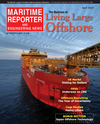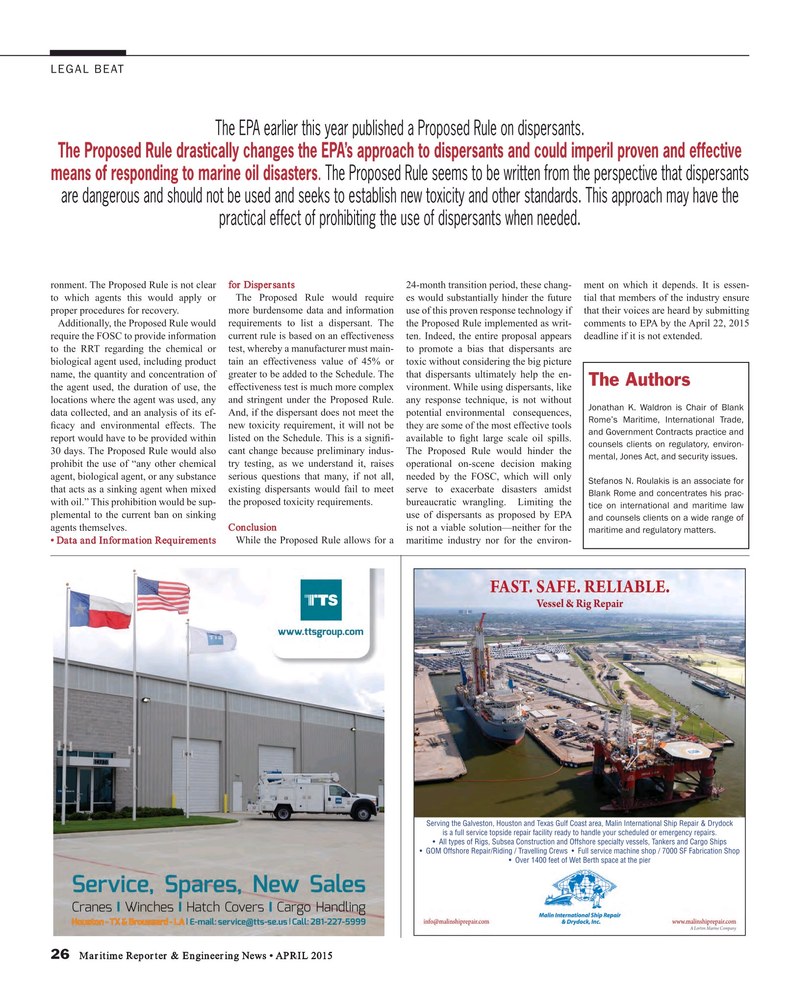
Page 26: of Maritime Reporter Magazine (April 2015)
Offshore Edition
Read this page in Pdf, Flash or Html5 edition of April 2015 Maritime Reporter Magazine
LEGAL BEAT
The EPA earlier this year published a Proposed Rule on dispersants.
The Proposed Rule drastically changes the EPA’s approach to dispersants and could imperil proven and effective means of responding to marine oil disasters. The Proposed Rule seems to be written from the perspective that dispersants are dangerous and should not be used and seeks to establish new toxicity and other standards. This approach may have the practical effect of prohibiting the use of dispersants when needed.
ronment. The Proposed Rule is not clear for Dispersants 24-month transition period, these chang- ment on which it depends. It is essen- to which agents this would apply or The Proposed Rule would require es would substantially hinder the future tial that members of the industry ensure proper procedures for recovery. more burdensome data and information use of this proven response technology if that their voices are heard by submitting
Additionally, the Proposed Rule would requirements to list a dispersant. The the Proposed Rule implemented as writ- comments to EPA by the April 22, 2015 require the FOSC to provide information current rule is based on an effectiveness ten. Indeed, the entire proposal appears deadline if it is not extended.
to the RRT regarding the chemical or test, whereby a manufacturer must main- to promote a bias that dispersants are biological agent used, including product tain an effectiveness value of 45% or toxic without considering the big picture name, the quantity and concentration of greater to be added to the Schedule. The that dispersants ultimately help the en-
The Authors the agent used, the duration of use, the effectiveness test is much more complex vironment. While using dispersants, like locations where the agent was used, any and stringent under the Proposed Rule. any response technique, is not without
Jonathan K. Waldron is Chair of Blank data collected, and an analysis of its ef- And, if the dispersant does not meet the potential environmental consequences,
Rome’s Maritime, International Trade, ? cacy and environmental effects. The new toxicity requirement, it will not be they are some of the most effective tools and Government Contracts practice and report would have to be provided within listed on the Schedule. This is a signi? - available to ? ght large scale oil spills. counsels clients on regulatory, environ- 30 days. The Proposed Rule would also cant change because preliminary indus- The Proposed Rule would hinder the mental, Jones Act, and security issues. prohibit the use of “any other chemical try testing, as we understand it, raises operational on-scene decision making agent, biological agent, or any substance serious questions that many, if not all, needed by the FOSC, which will only
Stefanos N. Roulakis is an associate for that acts as a sinking agent when mixed existing dispersants would fail to meet serve to exacerbate disasters amidst
Blank Rome and concentrates his prac- with oil.” This prohibition would be sup- the proposed toxicity requirements. bureaucratic wrangling. Limiting the tice on international and maritime law plemental to the current ban on sinking use of dispersants as proposed by EPA and counsels clients on a wide range of agents themselves. Conclusion is not a viable solution—neither for the maritime and regulatory matters.
• Data and Information Requirements While the Proposed Rule allows for a maritime industry nor for the environ-
Serving the Galveston, Houston and Texas Gulf Coast area, Malin International Ship Repair & Drydock is a full service topside repair facility ready to handle your scheduled or emergency repairs. s

 25
25

 27
27
